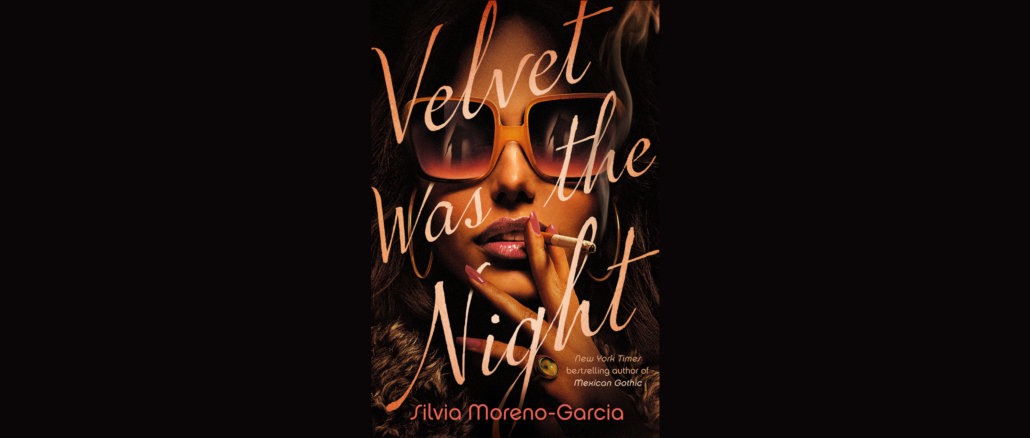
Thankfully for readers the world over, Mexican-Canadian (she was born and raised in Mexico and migrated to Canada when she was twenty-three) author, Silvia Moreno-Garcia, didn’t listen to those in the publishing industry who told Silvia patronisingly and somewhat harshly that books set in Mexico wouldn’t sell (as Silvia told in a “L.A. Times interview). Now, many of Silvia’s novels and short stories are set in Mexico, and sales have soared (she is a New York Times bestselling author).
When former United States President, Barack Obama put out his 2022 “Summer Reading List” recently, he listed Silvia’s dark, yet hopeful, 1970s Mexican noir (crime) novel, “Velvet was the Night”, as one of his favourite books that he’s read this year.
“Velvet was the Night” takes place predominantly in Mexico City (the capital of Mexico), in the summer of 1971. This soaringly ambitious and acutely delivering novel vividly and recalcitrantly portrays, in it’s opening pages, the actual event of “The Corpus Christi Massacre” (El Halconazo). The massacre was a student protest that numbered in the thousands on the tenth of June, 1971, in Mexico City. Blood was shed and 120 students’ lives were cruelly lost when the Mexican government ordered a paramilitary group to go in.
Elvis (an adopted name), one of the novel’s two chief protagonists, is a twenty-one year old idealist who likes listening to records playing the music of the day and looking up a different word in the dictionary each day to expand his mind. Terrifyingly, Elvis is also a “Hawk” in Mexico City. It is his job (ordered by his highly intimidating boss, El Mago) to infiltrate the initially peaceful student demonstration on the tenth of June 1971, by “carrying signs with the face of Che plastered on them and chanting slogans like ‘Freedom for the political prisoners!’ It was a ruse, a way to allow them (the Hawks) to get close to the protesters”. Elvis goes on to punch the students, other Hawks shooting into the air and using kendo sticks against the students. After Elvis and his crew’s stealthy inroads at the rally, they are to get a hold of journalists and take cameras.
Elvis has been with the Hawks for two years, after harking from an impoverished childhood and leaving school at thirteen, and “The chief requirement of a Hawk was he needed to look like a student so he could inform on the activities of the annoying reds (communists) infesting the universities”. In Elvis’s unit, he finds himself working alongside two macabre and volatile characters known as El Guero and the Antelope.
Connected to Elvis’s story, though in a disparate and redeeming way, is thirty year old legal secretary, Maite. If Elvis’s life is stoically threaded with drama and thuggery, Maite’s existence is entirely uneventful, predictable and mundane. Maite lives alone in an apartment building, with a nosy super, where Maite has only her parrot for company. Maite vehemently devours comic books called “Secret Romance”, books she lives vacariously and dreamily through.
Maite has money worries (she can’t afford to pick up her car from the mechanic as she doesn’t have the money to pay the bill), unreliable bosses, and a mother who demonstrably disapproves of Maite’s life, a life Maite’s mother compares to Maite’s younger, married and child-rearing sister, Manuela (Manuela also has a secretarial job in a better firm than Maite).
The greyness and paleness of Maite’s life takes on a tinge of glittery promise when her new neighbour in her apartment complex, Leonora, asks Maite to feed her cat while Leonora is away for a few days. Leonora (twenty-one), in contrast to Maite, who is described as being ordinary looking and desultory in nature, is stunningly beautiful, bohemian and an art student at university. Maite dutifully feeds the cat, as well as gleefully pocketing for herself a memento from Leonora’s apartment (Maite has been stealing from department stores and shops, as well as private homes where she looks after pets, trinkets for herself for years).
Initially eerily and perturbingly, and later menacingly and jaw-droppingly, when Leonora doesn’t return to her apartment when she said she would, Maite finds herself meeting with Ruben, a twenty-one year old print shop worker who Leonora in a phone call refers Maite to. Grenades explode and reign detritus on Maite and Ruben’s lives’, as they team together to find Leonora, who they discover is a member of a dissident art collective association (Asterisk). Vibrating and pulsating with the gleaned knowledge that Leonora is in possession of a camera with incriminating photos of the Hawks, a camera that others come to Leonora’s apartment in search of, Maite and Ruben are ‘on the case’.
Unerringly and systematically, however, Elvis, El Guero and the Antelope are also robustly on the case, as they have been assigned by El Mago to find Leonora, in addition to the camera. Surveillance of Maite and Ruben ensues, linked with a visit to Maite by the ‘secret police’ when she is at work one day.
Connivingly and audaciously, the Mexican government is in bed with the Hawkes, the military, the police and the American CIA. The public line of the Mexican government is that the Hawks do not exist, although Mexican citizens know them to be a presence. As Ruben declares at one stage to Maite, “The CIA is terrified of communists in Latin America and Mexico is dangerously close to Cuba”.
Will Maite and Ruben find Leonora before Elvis and his squad do? Is Leonora’s life in danger, and if so to what degree, and by who exactly? Will Maite ever have the life that she’s dreamed of, a life in which she is swept off her feet by a man who is like one of the handsome and ebulliently charming heroes from Secret Romance? Who is the dashing and charismatic Emilio, an ex-boyfriend of Leonora, who Maite meets, who may or may not be a key to the Leonora case? Will Elvis forever be a Hawk, forever causing mayhem? Who is the poised journalist, Jessica?
Silvia has written a superlative novel of intelligence, insight, wisdom and poignancy. It is devastating to think that innocent students were in danger in Mexico, for simply voicing their harmless opinions at a time of extreme paranoia by the Mexican and American governments, where deadly orders could be given on a whim, and peoples’ idealism and dreams could be brutally and overnight curtailed.
Thank you to Barack Obama for putting “Velvet was the Night” on your Summer Reading List (always a trustworthy source of reading ideas) this year. Monumental thanks to Silvia for having the courage and dedication to write “Velvet was the Night”. I was educated about a time and place that I knew so little of, and am now so proud of the bravery and stoicism of so many in Mexico in the 1970s to speak up for what they believed, and to not be deterred from having a better life. Bravo Silvia, and well done.

